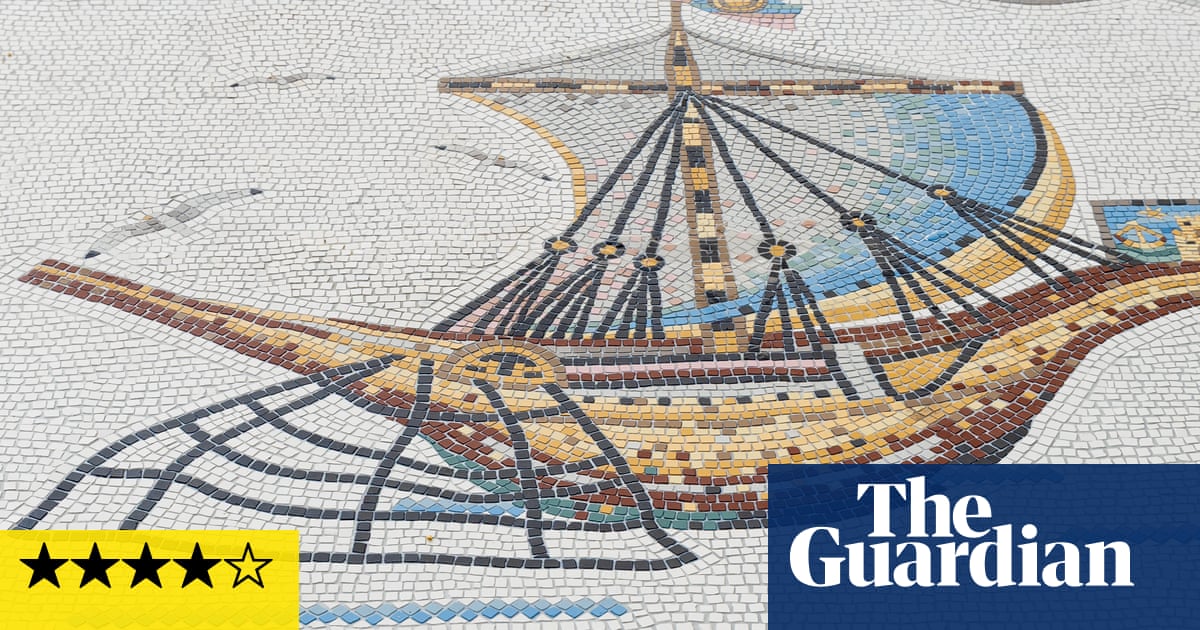It would be too simple to say that Jeremy Deller is interested in history. It would be more accurate to say he’s interested in things that aren’t there; or things that were once there; or perhaps things that could have been there. Protesting miners, deceased soldiers, inflatable sites of pagan worship have all been created or re-created by the Turner prize-winning artist, who has now turned his hand to a “speculative [Roman] mosaic” for Scarborough’s Wild Eye coastal art and nature trail.
Created with sculptor Coralie Turpin, Deller’s mosaic is a “semi-trick” – a suggestion of a Roman masterpiece that has been uncovered on the shores of the seaside town with genuine Roman history. On the cliffs above the work sits the remains of a Roman signal station, and the mosaic is fragmented and inaccurate as if made from memory rather than a photograph, generating a sense of authenticity. “In 100 years’ time – or whenever – when this is all underwater and it is rediscovered, someone will think ‘Fuck, there was a Roman villa here,’” says Deller.
What is actually there is a sea-watching station. With free-to-use telescopes, it’s one of England’s best places for viewing cetaceans – a group of aquatic mammals that includes porpoises, dolphins and whales. So, when Deller was asked if he could develop a work for the location, he had the difficult task of creating something that didn’t conflict with the view. A floor-based piece was the natural solution and it depicts many of the creatures we might spot with enough patience.
Roman Mosaic c2025 is at once joyful and violent; a large whale swoops under a ship, a seal snaps at a fish, an octopus tussles with a crab. There are specific Scarborough references, such as the walrus who made headlines when he stopped in the town in 2022, and a tiny Arctic auk spotted during a research trip out to sea. Deller’s signature playfulness is found in the smiley face flag on the ship, and the Roman god in the top corner who is doing his best to blow the whole scene away. The tiny tiles are expertly placed by Turpin to generate movement, putting the piece in motion – as if the creatures might dive back into the North Sea at any moment.
The sea is not always a comfortable companion for art displays. Even when the tide is low and the breeze is gentle, the hiss of the waves and the vast blue constantly draws the gaze upwards and out. But all the pieces on the Wild Eye trail understand this and instead of trying to compete with the sea, or nature more broadly, they embrace it. Invisible Dust – the non-profit organisation which initiated the Wild Eye project with the Yorkshire Wildlife Trust – works to unite artists and scientists to produce climate-conscious art. For them, the sea – or what’s in it – is as important as the pieces commissioned by their impressive roster of British artists.
Along with Deller, Ryan Gander, Paul Morrison, Shezad Dawood with Daisy Hildyard, and Emma Smith have created site-specific works to connect the people of Scarborough with the natural world around them. The most successful ones do this overtly.
Deller’s mosaic teaming with local creatures is immediately accessible, as is Paul Morrison’s marine grade stainless steel sculpture of seaweed. Sea Oak is a shimmering slice of bladderwrack seaweed with a reflective surface that absorbs the blue above and below. Seaweed is an efficient carbon sink and valuable habitat for marine wildlife, and yet it is very often an overlooked element of the British seaside. Morrison restores its value by putting it on a plinth.
Nearby, Dawood – in collaboration with writer Hildyard – presents one of a series of augmented reality works found along Scarborough seafront that explore an imagined future for costal environments and their inhabitants. This involves scanning a QR code and pointing my phone at the sea to see various hybrid creatures emerging to Hildyard’s storytelling. It is interesting enough but there is something disconnecting about looking at the sea through my iPhone, and without much of a physical presence I wonder how many passersby will engage with this.
after newsletter promotion
In the grounds of Scarborough Castle is Gander’s We Are Only Human (Incomplete Sculpture for Scarborough to Be Finished By Snow). The large sculpture, cast in low-carbon concrete with limestone formed of shells and skeletons from prehistoric sea creatures, is based on a dolos, the hefty forms that line the seafront to prevent erosion. Up on the edge of a cliff, surrounded by greenery and wildflowers, its hardness and bright whiteness feels out of place, as if it has arrived from another place. Its jarring presence highlights the discomfort we will feel in a future world where rising sea levels have deposited a dolos on the top of a cliff.
A slow stroll or cycle between the works, absorbing the local fauna and wildlife, would be the ideal way to take in all the art. Emma Smith assists us in this leisurely approach by installing several resting points along the Cinder Track – a 21-mile coastal trail linking Scarborough and Whitby. Her sculptural “seats” – made from exquisite “Swaledale fossil” limestone – place the viewer inside nature, initiating curiosity and calm, and a total appreciation of the surrounding greenery that – should we not change our ways – might not last as long as Deller’s mosaic.
